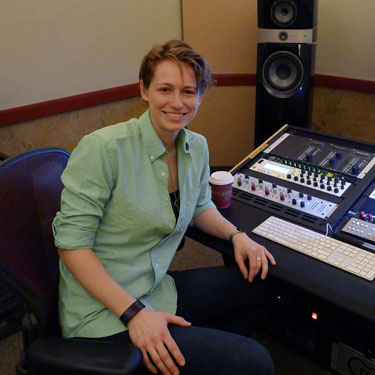|
 Piper Payne is an accomplished mastering engineer, recording engineer, and audio archivist who is currently working out of Michael Romanowski's mastering studios in San Francisco, California. Piper Payne is an accomplished mastering engineer, recording engineer, and audio archivist who is currently working out of Michael Romanowski's mastering studios in San Francisco, California.
With an undergraduate degree from the University of Michigan, a graduate studies certificate from the University of Stavanger in Norway, a coveted position with Bob Katz at Digital Domain in Orlando, Florida, and a residency as Senior Audio Associate at the Banff Centre in Alberta, Canada, Payne has not only lived throughout the country, continent, and world, but has internalized a diversity of audio technologies, philosophies, and techniques. While in Norway, she became a member of the beta team for Metric Halo's flagship ULN-8 interface, and it has remained an irreplaceable fixture in both her recording and mastering work ever since. An audio evangelist, Payne has turned other professionals on to the Metric Halo ULN-8; Michael Romanowski's studios are now home to seven for recording, mixing, and mastering!
"I went to work with Bob Katz after my graduate studies, and he and I held our own interface shoot-out shortly after I arrived," Payne said. "The Metric Halo ULN-8 held its own against everything. Only one other converter [at nearly three times the price per channel] sounded as good as the ULN-8. For my mastering work, the ULN-8's transparency is paramount. Whatever I'm doing, I never want to hurt the audio – I never want to put a sound on the sound. Other converters have a 'digital sound' that Metric Halo avoids." Although Payne regularly scrutinizes all new products and technologies, including interfaces, the Metric Halo ULN-8 remains at the heart of her rig.
Payne's mastering work relies heavily on both analog and digital technologies. Sonic Studio's soundBlade HD is her preferred digital playback, editing, and recording software. SoundBlade integrates seamlessly with Metric Halo's MIO Console, which provides 80-bit summing and comprehensive routing facilities between all of her virtual software inputs and outputs and the hardware inputs and outputs of the ULN-8. "I always use MIO Console for summing," Payne said. "I prefer its sound to everything else." The outboard gear that she regularly uses includes a Manley Langevin Mini Massive EQ, a Neve Portico II Master Bus Processor, an EAR 822 EQ, a GML 8900 compressor, a Weiss digital EQ1, and a Weiss digital DS1 dynamics unit.
"Metric Halo's MIO Console is tremendously flexible," Payne added. "Not only can I easily reroute my mastering chain, but I can check and calibrate each piece of gear as I go. And of course the fidelity of the ULN-8 is critical. I'm using the analog components at line level and the converters in both directions. It's a lot of sound and conversion all going through one box, and the ULN-8 introduces no noise and no artifacts." Payne always uses the highest possible resolution, and the ULN-8 accommodates that preference with up to 24-bit/192kHz performance and a flat 3Hz to 64kHz frequency response.
Payne views each project with fresh eyes, taking the open-ended goal of best serving the project in whatever way is needed. "If the mix comes to me perfectly balanced, then I'm happy to simply do some level matching and sequencing," she said. "But the truth is, that rarely happens. On the other end, if a project arrives with so many problems that I can't fix them without messing up other aspects of the work, then I'll send it back to the mix engineer to request a remix. If I can't help the project, I try not to hurt it. Ultimately, communication is key. It's important that everybody involved is on board with exactly how far a project can go – no one can turn a 'C-grade' mix into an 'A+' master."
Payne also regularly records on location throughout the Bay Area, using a collection of Metric Halo ULN-8s for a compact, high-fidelity front end. In addition to classical concerts, she records rock acts, which have included Edward Sharpe and the Magnetic Zeros, Death Cab for Cutie, Mumford & Sons, Matt Nathanson, and The Airborne Toxic Event. "Ultimately, what amazes me about the ULN-8 is that it does so many things, and it does them all so well," she said. "There are great preamps, converters, and signal processors out there. But to have all of that inside a single box that's rock-solid reliable," she concluded, "that's amazing!" |